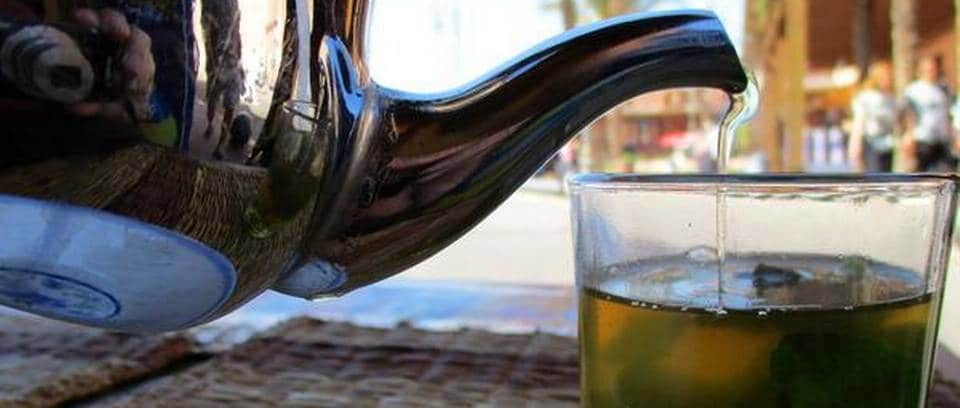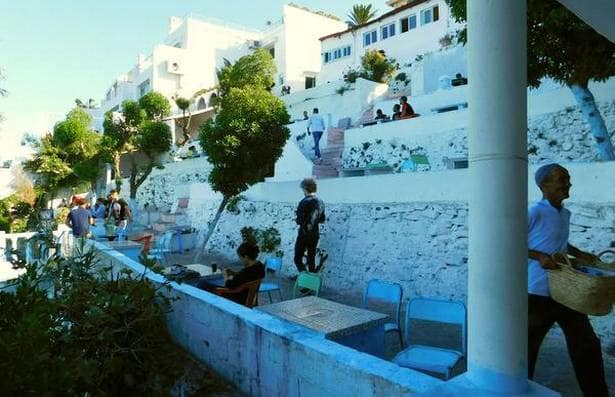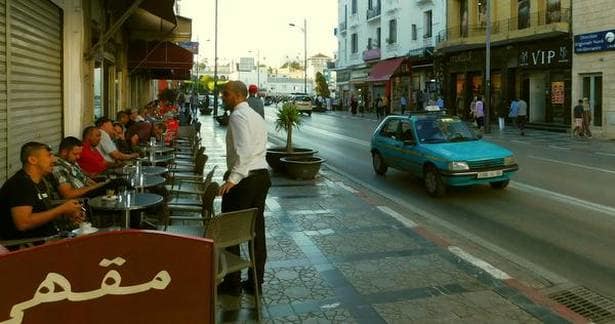The Hindu Business
Zac O’ Yeah
A lot of this Moroccan town’s charm brews in its countless teahouses and cafés.
Café culture has been an integral part of creative life all over the world. Think of old Vienna or Paris, think of the coffee houses of Kolkata or any town in Kerala, and how they are intellectual hubs where local thinkers hold court.
The cafés and teahouses of Tangier in Morocco are superb and, although I don’t follow much of the intense discussions in the Maghrebi dialect of Arabic, I immediately feel at home, wandering from one café to the next.
Paul Bowles, author of The Sheltering Sky, who lived and died in Tangier, wrote: “The traditional café in this part of the world is conceived of as a club where, in addition to enjoying the usual amenities of a café, a man may, if he wishes, eat, sleep, bathe… Only there does the man feel free to talk, smoke his kif pipe, play or listen to music, and even, if the spirit moves him, to dance a little in front of his friends.” Well, I don’t lap dance or smoke drugs but do smell the kif hashish in every other café, as I am alternating between the local versions of coffee and tea. A Café Marocaine (a glass of muscular espresso topped with boiled milk) or mint tea, the national beverage nicknamed Moroccan whiskey due to its colour, sets me back by 10 dirhams (₹75) and allows me unlimited time to write notes to self.
The most time-warped café in town is the elusive Baba. Also known back in the hippie days as Abdelkader’s Kif Café, it’s hidden up a narrow, steep set of steps in the cobweb of alleys that make the heart of the old Medina. It has been frequented by the likes of Keith Richards (a famous snap of him smoking up hangs on the wall), Kofi Annan and the king of Sweden. Here it is entirely possible to think you are back in 1943, when the café opened, and it doesn’t appear to have ever been cleaned since then. It overlooks the Sidi Hosni mansion where Barbara Hutton, the “rich little poor girl” who inherited the Woolworths millions and married Hollywood star Cary Grant, threw legendary night-long parties to squander her fortune, and beyond it I can see the harbour and cobalt blue sea. A few giggly Moroccan girls smoke pot at a table. At another sits a man wearing a shirt but no pants. The proprietor asks me cheerfully, “Will you have some tea with us?”
“I’d love to,” I say. After tea, I take a refreshing walk a few kilometres west through a genteel neighbourhood called Marshan, until I find Café Hafa, which means ‘café on the cliff’. This, perhaps the most famous café in all of Africa, was started in 1921 by an elderly Frenchman as, quaintly enough, a cheap drinking den called La Guinguette Fleurie (‘the flowering boozer’) and it remains one of the places that doesn’t seem to have changed a bit in almost a hundred years — except there’s no alcohol now. Here one may, on a lucky day, spot Mick Jagger, who supposedly owns a secret holiday home nearby. But even if there’s no Jagger to gawk at the views are phenomenal: All the way across the straits to Gibraltar in Spain.
Refill point: Café Hafa, which means ‘cafe on the cliff’, has been around since 1921
The menu is simple: Mint tea and nothing else. A boy climbs up and down the terraces with a steel-wire basket (much like one sees chaiwallahs in India do) handing out tall glasses and collecting advance payment — 8 dirhams (₹60) a pop. The tea in Morocco is typically made with green Taiwanese tea, is very sugary (minimum four teaspoons) and full of freshly crushed spearmint leaves. Interestingly, the national beverage was introduced in Tangier by the British, who received the town from the Portuguese along with Bombay in the 1660s, as part of the dowry of Catherine of Braganza, sister of the king of Portugal, when she was marrying the ‘Merry Monarch’ Charles II!
The cafés don’t serve much food, so whenever I get hungry, I step into any bar and order a beer, typically 18 dirhams (₹135) for local brands such as Stork or Flag, and alongside the bartender without fail sets down a couple of plates of complimentary starters. I notice customers bring their own flatbreads to supplement the fare. It occurs to me that the famous pubs of my hometown, Bengaluru, with their deep-fried, red-painted chicken 65 and over-spiced-and-priced gobi Manchurian, could learn from Tangier’s bartending culture. Why terrorise customers’ guts and insist on ‘No Outside Food Allowed’, unless you can offer good snacks?
****
Meanwhile, there are plenty of free lunches at the hospitable dives around Boulevard Pasteur, the main street. L’Ibis and Rubis Grill try to outdo each other with pickled olives, bean stews and spicy lentils, and, once in a while, I even get a delicious chicken paella. At Lisba, bow and arrows hang above the bar and the hunting theme includes the head of a deer wearing sunglasses on the opposite wall. One local man finishes five beers in the time I drink two, then stumbles on a bar stool and falls straight out through the door. Another drunk is a shoe-shiner, who offers to polish my boots while I snack on what look like curried condoms but turn out to be savoury intestines. Meanwhile at Le Number One, a smart 50-year-old restaurant where a jolly proprietor, who writes witty adages and hangs them from the ceiling, serves me an onion and tomato salad or sometimes a potato salad as he exclaims, whenever I stop by, “Haven’t seen you for so long. You’ve been too much out in the sun.” You bet, and my feet are aching from the sightseeing, I think to myself. The compact Tangier is great for sightseeing on foot as almost everything is around the corner from everything else. But in my enthusiasm, I’ve walked so much that I get blisters even between my toes. That’s a first.
Sip and walk: Outdoor cafés on Boulevard Pasteur, the main street of Tangier
The free bar snacks actually taste better than what I eat in fancy restaurants where I pay for my food. In 1954, British-Canadian artist-writer Brion Gysin, who was one of the most colourful and creative people to settle in the town, inaugurated a depraved nightclub known as 1001 Nights, up by the Kasbah palace, which I’m determined to locate. Writes Christopher Isherwood in his Diariesin 1955, “One of our greatest experiences in Tangier was a visit to the Thousand and One restaurant [sic]. This is an old Arab house, beautifully decorated by a painter named Brion Gysin. They serve genuine Arab food — couscous and so forth… There is an orchestra and they have two dancing boys… The boys were very interesting to watch — their negligent grace, their vague yet exact gestures, their delicately mocking salutes when you gave them money, which they placed in their turbans. Their hip movements and flirtatious play with their scarves is exquisitely campy and yet essentially masculine: this is in no sense a drag show.”
But my lunch is most disappointing. Until recently there used to be jahjouka musicians trance-jamming at the restaurant — the same ones who collaborated with The Rolling Stones on songs such as Continental Drift — but these days the legendary nightspot has turned into a rather lacklustre and forlorn eatery called Le Detroit Palace, living off its old fame with a who’s-who list on its signboard that features everyone from Salvador Dalí to Truman Capote. Today, I’m the only customer. There’s no beer and the chicken brochettes (similar to kebabs) for 80 dirhams (₹600) taste dead rather than deadly. After I finish, I notice the staff has carried away one of the caged parrots that decorated the dining hall when I arrived. I have a horrendous suspicion that the kebabs may not have been chicken after all.
I decide to stick to the yummy snacks at my favourite shady joints and end up having the gourmet trip of my life. For free. When I do get a sweet craving, I stop by the tiny Nougat de Tangier, a 1952 vintage 2 sq-m store in the old town that sells only one thing: Nougat. At 200 dirhams (₹1,500) a kilo it’s a steal compared to the 10 times higher rate I notice for the same confection in the airport at Paris, where my flight out of Morocco lands a week later.
Zac O’Yeah is a part-time travel writer and part-time detective novelist;
Email: zacnet@email.com











